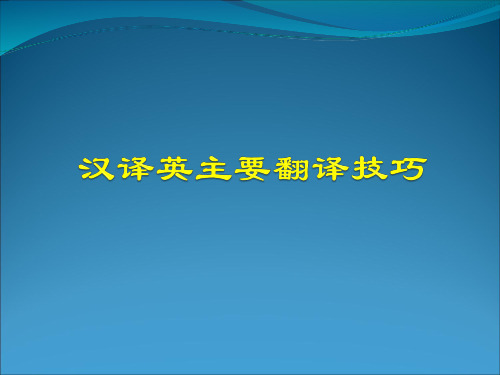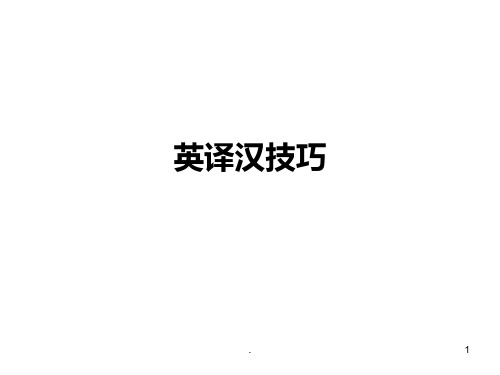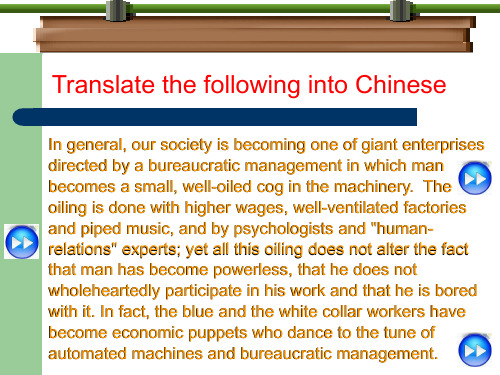翻译汉译英课件翻译技巧
合集下载
英汉互译八种技巧 ppt课件

这是一个胜利的大会,一个团结的大会。
(表语有多个修饰语时,重 of fear as well as of admiration.
❖ 无知是恐惧的根源,也是崇拜的根源。
3)重复名词,取代代词 ❖ Don’t be afraid of failure, as it is the mother
❖ 4. 保留习语中的重复 ❖ Long, long ago… ❖ 很久很久以前,··· ❖ The flower is very ,very beautiful. ❖ 这花可美可美了。 5,英语强势词的译法 Whatever, whatsoever, whoever, whomever,
whichever, whenever, wherever, however.
❖ 1.重复名词 ❖ 1)重复做宾语的名词
❖ We have to analyze and solve problems. ❖ 我们要分析问题,解决问题。
❖ Let’s revise our safety and sanitary regulations. ❖ 我们来修改安全规则和卫生规则吧。
❖ Gentlemen may cry, peace, peace --- but there is no peace.
❖ 先生们尽管可以高呼和平,和平!但是依然没有和 平。
❖ We must enrich our cultural and material lives.
我们必须丰富我们的精神生活和物质生活。 (宾语前有多个定语时,要重复这个做宾语 的名词)
2)重复做表语的名词
This is a victorious conference that shows our unity.
❖ You may take whatever away for all I care. ❖ 你想拿什么拿什么,我才不管哩。
(表语有多个修饰语时,重 of fear as well as of admiration.
❖ 无知是恐惧的根源,也是崇拜的根源。
3)重复名词,取代代词 ❖ Don’t be afraid of failure, as it is the mother
❖ 4. 保留习语中的重复 ❖ Long, long ago… ❖ 很久很久以前,··· ❖ The flower is very ,very beautiful. ❖ 这花可美可美了。 5,英语强势词的译法 Whatever, whatsoever, whoever, whomever,
whichever, whenever, wherever, however.
❖ 1.重复名词 ❖ 1)重复做宾语的名词
❖ We have to analyze and solve problems. ❖ 我们要分析问题,解决问题。
❖ Let’s revise our safety and sanitary regulations. ❖ 我们来修改安全规则和卫生规则吧。
❖ Gentlemen may cry, peace, peace --- but there is no peace.
❖ 先生们尽管可以高呼和平,和平!但是依然没有和 平。
❖ We must enrich our cultural and material lives.
我们必须丰富我们的精神生活和物质生活。 (宾语前有多个定语时,要重复这个做宾语 的名词)
2)重复做表语的名词
This is a victorious conference that shows our unity.
❖ You may take whatever away for all I care. ❖ 你想拿什么拿什么,我才不管哩。
汉译英翻译技巧PPT课件

汉译英翻译技巧
Sub Title here
1
一)词的翻译
• >>1.词义选择 • (1)语境词 • 例子: • 原句:手机刷新了人与人的关系。
• 译文:Cell phone have altered the
relationship among people. • 分析:“刷新”此处实际是指“改变”,
4
一)词的翻译
• >>3.词的增补 • (1)语法需要 • (2)意思表达需要 • (3)文化背景解释的需要
• >>4.词的减省 • >>5.词的代替(用代词代替重复的部分)
5
二)句的翻译
• >> 1)确立主干 • (1)确定主语 • 例文:这个地方比较多雨。 • 译文1:It rains a lot in this area. • 译文2:This area sees much rain. • 译文3:There is much rain in this area. • 分析:汉语主语的角度变化很少,而英语则变化
12
写在最后
成功的基础在于好的学习习惯
The foundation of success lies in good habits
13
结束语
当你尽了自己的最大努力时,失败也是伟大的, 所以不要放弃,坚持就是正确的。
When You Do Your Best, Failure Is Great, So Don'T Give Up, Stick To The End 演讲人:XXXXXX 时 间:XX年XX月XX日
2)段落的连贯 段落的连贯(coherence)指的是内容情节的 串联,或者逻辑关系上的贯通,总得来说 就是有完整的语义关系。
Sub Title here
1
一)词的翻译
• >>1.词义选择 • (1)语境词 • 例子: • 原句:手机刷新了人与人的关系。
• 译文:Cell phone have altered the
relationship among people. • 分析:“刷新”此处实际是指“改变”,
4
一)词的翻译
• >>3.词的增补 • (1)语法需要 • (2)意思表达需要 • (3)文化背景解释的需要
• >>4.词的减省 • >>5.词的代替(用代词代替重复的部分)
5
二)句的翻译
• >> 1)确立主干 • (1)确定主语 • 例文:这个地方比较多雨。 • 译文1:It rains a lot in this area. • 译文2:This area sees much rain. • 译文3:There is much rain in this area. • 分析:汉语主语的角度变化很少,而英语则变化
12
写在最后
成功的基础在于好的学习习惯
The foundation of success lies in good habits
13
结束语
当你尽了自己的最大努力时,失败也是伟大的, 所以不要放弃,坚持就是正确的。
When You Do Your Best, Failure Is Great, So Don'T Give Up, Stick To The End 演讲人:XXXXXX 时 间:XX年XX月XX日
2)段落的连贯 段落的连贯(coherence)指的是内容情节的 串联,或者逻辑关系上的贯通,总得来说 就是有完整的语义关系。
汉译英主要翻译技巧精品PPT课件

替换法
另外一种方法是化学方法。 Another method is the chemical process. / Another
approach is the chemical method.
同极电荷相斥,异极电荷相吸。 Electrical charges of a similar kind repel each other while
倒置法
敌我矛盾 contradictions between ourselves and the enemy
钢铁工业 the iron and steel industry
国际经济新秩序 a new international economic order
社会主义的现代化强国 a modern and strong socialist country
危险时也要保持冷静。 You should keep calm even when you are in danger.
天高云淡。 The sky is high and the clouds are pale.
车未停稳,切勿上下。 Never get on or off the bus before it comes to a standstill.
reaction.
我们建议立即做出决定。 We advise an immediate decision.
声音的频率、波长和速度三者是密切相关的。 The frequency, wavelength, and speed of sound are
closely related.
增补法
白求恩大夫一到前线就立刻开始工作。 Dr. Bethune set to work as soon as he came to the front.
英汉互译实践与技巧课件

旅游文本翻译案例
总结词
准确传达信息
详细描述
旅游文本翻译要求准确传达原文信息,包括景点名称、 历史背景、文化特色等,同时要符合目标语言的表达习 惯,使游客能够轻松理解。
总结词
语言流畅自然
详细描述
旅游文本翻译要注重语言的流畅性和自然度,避免生硬 直译,使游客能够感受到原文的美感和意境。
总结词
保留原文风格
总结词
准确传达意思
详细描述
日常用语翻译要求准确传达原文意思,注意语言习惯和文化差异,避免出现歧 义或误解。
日常用语翻译
总结词:流畅自然
详细描述:翻译时需保持语言的流畅自然,符合目标语言的表达习惯,避免过于直译或硬译。
日常用语翻译
总结词
注意语气和情感
详细描述
翻译时需注意原文的语气和情感,尽可能在 目标语言中传达出相同的语气和情感。
保留原文文化内涵
详细描述
英汉两种语言背后蕴含着丰富的文化背景和传统习俗。在进行英汉互译时,译者需要充 分考虑到文化差异,对一些具有特定文化内涵的词汇和表达方式进行适当的处理。这包 括对文化概念的直译、意译、解释性翻译等策略的使用,以保留原文的文化内涵,同时
使译文更加易于理解。
语态转换
总结词
传达原文情感色彩
商务英语翻译
总结词
考虑文化差异
详细描述
翻译时需考虑文化差异,避免因文化背景不同而产生 的误解,确保信息的有效传递。
商务英语翻译
总结词
遵循行业惯例
详细描述
商务英语翻译需遵循行业惯例和规范,译文要符合特定 行业的表达方式和习惯。
科技英语翻译
总结词
术语准确统一
详细描述
科技英语翻译要求术语准确统一,确 保专业性和准确性,避免出现错译或 误译。
翻译汉译英课件翻译方法Translationmethods

• 终朝只恨聚无多, 及到多时眼闭了 。
• 世人都晓神仙好, 只有娇妻忘不了 ,
Discussion of Assignment
The Won-Done Song
Men all know that salvation should be won, But with ambition won’t have done, have done. Where are the famous ones of days gone by? In grassy graves they lie now, everyone. Men all know that salvation should be won, But with their riches won’t have done, have done. Each day, they grumble they’ve not made enough When they’ve enough, it’s goodnight everyone! Men all know that salvation should be won, But with their loving wives they won’t have done. The darlings every day protest their love, But once you are dead, they’re off with another one. Men all know that salvation should be won, But with their children won’t have done, have done. Yet though of parents fond there is no lack, Of grateful children saw I ne’er one.
• 世人都晓神仙好, 只有娇妻忘不了 ,
Discussion of Assignment
The Won-Done Song
Men all know that salvation should be won, But with ambition won’t have done, have done. Where are the famous ones of days gone by? In grassy graves they lie now, everyone. Men all know that salvation should be won, But with their riches won’t have done, have done. Each day, they grumble they’ve not made enough When they’ve enough, it’s goodnight everyone! Men all know that salvation should be won, But with their loving wives they won’t have done. The darlings every day protest their love, But once you are dead, they’re off with another one. Men all know that salvation should be won, But with their children won’t have done, have done. Yet though of parents fond there is no lack, Of grateful children saw I ne’er one.
英译汉翻译技巧必看PPT课件

• 他三岁丧父,所以记不起父亲了。
• Strange enough they were the same age to the day.
• 说来也巧, 他俩年纪一样大, 而且还是同 日的。
.
15
5.合译法
• 合译是将原文的两个或几个分开叙述的意 思或层次合并重组,如将两个分句合译为 一个简单句,或两个简单句合译成一个复 合句等, 使全句的结构更加紧凑,语气更 加顺通。
• 直译: 好的婚姻不会仅仅发生—它们需要 大量的爱和大量的工作。
• 意译:幸福的婚姻不是凭空发生的---它需 要你为它付出大量的爱和做大量的工作。
• 或:美满的婚姻不会从天上掉下来---你必 须为它付出大量的爱,做大量的工作。
.
5
• 很显然,本句话的意译要比直译更符合汉 语表达习惯。当然,一句话并不限于一种 译法,要根据具体需要而定。一般来说, 在英汉翻译考试中,如果直译能达意就用 直译,如果直译效果不好,就应该考虑意 译。只要译文内容忠实,意思明白就行了。
• The electronic computer is chiefly characterized by its accurate and rapid computation.
• 计算机的主要特点是计算准确迅速。
.
21
3.英语名词→汉语形容词
• 英语原文中有形容词加后缀构成的名词, 翻译时可转化为汉语的形容词。 如:
• He came to my home for help. • 他来到我家请求帮助。 • I love having Friday off. • 我喜欢周五休息。 • I am for the former. • I am against the latter.
• Strange enough they were the same age to the day.
• 说来也巧, 他俩年纪一样大, 而且还是同 日的。
.
15
5.合译法
• 合译是将原文的两个或几个分开叙述的意 思或层次合并重组,如将两个分句合译为 一个简单句,或两个简单句合译成一个复 合句等, 使全句的结构更加紧凑,语气更 加顺通。
• 直译: 好的婚姻不会仅仅发生—它们需要 大量的爱和大量的工作。
• 意译:幸福的婚姻不是凭空发生的---它需 要你为它付出大量的爱和做大量的工作。
• 或:美满的婚姻不会从天上掉下来---你必 须为它付出大量的爱,做大量的工作。
.
5
• 很显然,本句话的意译要比直译更符合汉 语表达习惯。当然,一句话并不限于一种 译法,要根据具体需要而定。一般来说, 在英汉翻译考试中,如果直译能达意就用 直译,如果直译效果不好,就应该考虑意 译。只要译文内容忠实,意思明白就行了。
• The electronic computer is chiefly characterized by its accurate and rapid computation.
• 计算机的主要特点是计算准确迅速。
.
21
3.英语名词→汉语形容词
• 英语原文中有形容词加后缀构成的名词, 翻译时可转化为汉语的形容词。 如:
• He came to my home for help. • 他来到我家请求帮助。 • I love having Friday off. • 我喜欢周五休息。 • I am for the former. • I am against the latter.
《英汉互译技巧》PPT课件

The oiling is done with higher wages, well-ventilated factories and piped music, and by psychologists and "human-relations" experts. 这种润滑作用是靠增加工资、改善厂房的通风状况及播放轻 音乐,以及通过心理学家的疏导和人际关系专家的指导完成 的.
Translate the following into Chinese
The oiling is done with higher wages, well-ventilated factories and piped music and by psychologists and "human-relations" experts; 这种润滑作用是靠 增加工资、改善厂房的 通风状况及播放轻音乐, 以及通过心理学家 的疏导和人际关系专家的指导完成的.
Translate the following into Chinese
In general, our society is becoming one of giant enterprises directed by a bureaucratic management in which man becomes a small, well-oiled cog in the machinery. The oiling is done with higher wages, well-ventilated factories and piped music, and by psychologists and "humanrelations" experts; yet all this oiling does not alter the fact that man has become powerless, that he does not wholeheartedly participate in his work and that he is bored with it. In fact, the blue and the white collar workers have become economic puppets who dance to the tune of automated machines and bureaucratic management.
Translate the following into Chinese
The oiling is done with higher wages, well-ventilated factories and piped music and by psychologists and "human-relations" experts; 这种润滑作用是靠 增加工资、改善厂房的 通风状况及播放轻音乐, 以及通过心理学家 的疏导和人际关系专家的指导完成的.
Translate the following into Chinese
In general, our society is becoming one of giant enterprises directed by a bureaucratic management in which man becomes a small, well-oiled cog in the machinery. The oiling is done with higher wages, well-ventilated factories and piped music, and by psychologists and "humanrelations" experts; yet all this oiling does not alter the fact that man has become powerless, that he does not wholeheartedly participate in his work and that he is bored with it. In fact, the blue and the white collar workers have become economic puppets who dance to the tune of automated machines and bureaucratic management.
汉英翻译翻译技巧PPT课件

get cold feet 胆怯
mend one's fences 改善关系
谦虚态度 modesty 发展过程 development
稳定性 stability
灵敏性 sensibility
无知的表现 innocence 同情心理 sympathy
鸡毛蒜皮 trifling
单枪匹马 all by oneself
LOG原文中抽象或者比较抽象的单词、词组、 成语或句子用具体或者是比较具体的单词、词组、成语或者句 子来进行翻译,从而消除或降低语言差别给翻译带来的损失。
如:transportation 运输工具 translation 翻译作品
advertisement 广告资料 government 政府官员
LOGO
在翻译过程中把原文中抽象或者比较抽象的单词、词组、
成语或句子用具体或者是比较具体的单词、词组、成语或者句 子来进行翻译,从而消除或降低语言差别给翻译带来的损失。
如: 大吵大闹 raise the roof 公开认错 stand in the white sheet 有花不完的钱 have enough money to burn 话中有话 with the tongue in the cheek 机敏 keep one's eyes on the ball 坚决反对 put one's foot down; set one's face against 截然不同 oil and vinegar 鲁莽的人 a bull in a china shop 告发 put the finger on 甘苦差事 hold (carry) the baby 反应快 think on one's feet 保密 keep sth under one's hat
汉译英长句翻译(共6张PPT)

being mountainsW, fohreestns, wriveershaandd ptleacae,sIfocr ootuheldr usneos.t take my 中国乒乓球大奖赛ey的e最s 后fr一o天m,h刘e国r梁sm在男al子l,单d打el比ic赛a中te一h举a夺n魁ds后,,th干e脆利落地夺得大奖赛的4项冠军。
汉译英长句翻译 – 合并法
– 顺译法 – 倒置法 – 插入法
第,共6页。
汉译英长句翻译 进行汉译英长句翻译时,应该先通览原文的大概意思,再弄 清楚原文的句法结构,分析句子各个层次的含义和相互间的逻 辑关系,再根据英语表达特点,正确翻译出原文含义。翻译完 毕后,应再次审读译文,检查译文的内容是否详尽、结构是否 合理、语言是否地道。常见的汉译英长句翻译技巧有以下几种:
合并法
顺译法
倒置法 插入法
第2页,共6页。
合并法: 合并法是把若干个短句合并成一个长句。英语强调形合,结
构较严密,因此长句较多。所以汉译英时可采用连词、非谓语动 词、定语从句、独立结构等方式把汉语短句连成长句。
中国是个大国,百分之八十的人口从事农业,但耕地只占土地面积的十分 之一,其余为山脉、森林、湖泊和其他用地。
China is a large country with eighty percent of the population engaged in agriculture, but only one tenth of the land is farmland, the rest
China is a large country with eighty percent of the population engaged in agriculture, but only one tenth of the land is farmland, the rest being mountains, forests, rivers and places for other uses.
汉译英长句翻译 – 合并法
– 顺译法 – 倒置法 – 插入法
第,共6页。
汉译英长句翻译 进行汉译英长句翻译时,应该先通览原文的大概意思,再弄 清楚原文的句法结构,分析句子各个层次的含义和相互间的逻 辑关系,再根据英语表达特点,正确翻译出原文含义。翻译完 毕后,应再次审读译文,检查译文的内容是否详尽、结构是否 合理、语言是否地道。常见的汉译英长句翻译技巧有以下几种:
合并法
顺译法
倒置法 插入法
第2页,共6页。
合并法: 合并法是把若干个短句合并成一个长句。英语强调形合,结
构较严密,因此长句较多。所以汉译英时可采用连词、非谓语动 词、定语从句、独立结构等方式把汉语短句连成长句。
中国是个大国,百分之八十的人口从事农业,但耕地只占土地面积的十分 之一,其余为山脉、森林、湖泊和其他用地。
China is a large country with eighty percent of the population engaged in agriculture, but only one tenth of the land is farmland, the rest
China is a large country with eighty percent of the population engaged in agriculture, but only one tenth of the land is farmland, the rest being mountains, forests, rivers and places for other uses.
汉译英技巧PPT课件

❖ rob Peter to pay Paul ❖ 大开眼界
❖ open one's eyes; broaden one's horizon; be an eyeopener
❖ 团结就是力量
❖ Unity is strength.
❖ 活到老学到老
❖ One is never too old to learn ❖ 既往不咎
❖ 7. 哀莫大于心死。The greatest despair comes from a devastated _h_ea_rt__.
翻译下列词语,注意词语的不同搭配关系
❖ 1.浓茶
❖ Strong tea ❖ 浓墨
❖ Thick ink ❖ 浓烟
❖ Dense smoke ❖ 2. 治国
❖ Administrate a country
C-E
词的选择
❖ 一、根据上下文正确理解原文的词义
❖ 词的正确选择首先取决于对原文词义的确切理解,而对原文词义的确切 理解又取决于对原文上下文的推敲,英译汉情况如此,汉译英也是如此。 例如:
❖ (一)“情况”:这个词的基本意义与英语中的circumstances, situation,condition等词相近,但是究竟怎样翻译,还须根据上下文 来决定
❖ let bygones be bygones ❖ 留得青山在不怕没柴烧
❖ Where there is life, there is hope.
❖ 名利双收
❖ gain both fame and wealth ❖ 谋事在人成事在天
❖ Man proposes, God disposes. ❖ 实事求是
❖
(3)现在情况不同了。
❖
❖ open one's eyes; broaden one's horizon; be an eyeopener
❖ 团结就是力量
❖ Unity is strength.
❖ 活到老学到老
❖ One is never too old to learn ❖ 既往不咎
❖ 7. 哀莫大于心死。The greatest despair comes from a devastated _h_ea_rt__.
翻译下列词语,注意词语的不同搭配关系
❖ 1.浓茶
❖ Strong tea ❖ 浓墨
❖ Thick ink ❖ 浓烟
❖ Dense smoke ❖ 2. 治国
❖ Administrate a country
C-E
词的选择
❖ 一、根据上下文正确理解原文的词义
❖ 词的正确选择首先取决于对原文词义的确切理解,而对原文词义的确切 理解又取决于对原文上下文的推敲,英译汉情况如此,汉译英也是如此。 例如:
❖ (一)“情况”:这个词的基本意义与英语中的circumstances, situation,condition等词相近,但是究竟怎样翻译,还须根据上下文 来决定
❖ let bygones be bygones ❖ 留得青山在不怕没柴烧
❖ Where there is life, there is hope.
❖ 名利双收
❖ gain both fame and wealth ❖ 谋事在人成事在天
❖ Man proposes, God disposes. ❖ 实事求是
❖
(3)现在情况不同了。
❖
最新汉译英翻译技巧PPT课件

主动语态越来越成为主流 一般说来,被动语态用于科技英语中是为了迎合其表 达的需要。科技文章注重客观叙述,避免读者的主观臆断, 并且可以将新信息放在句首以突出其重要性,因而使用被 动语态,以免提及施事者。
被动语态的缺点: ① 被动语态比主动语态冗长,容易造成句子结构头 重脚轻影响读者的阅读效率。 ②并非所有被动语态句子都能起到突出新信息的作用。 基于以上观点,现代科技工作者提倡用主动语态撰写科 技文章。例如《Science》和《Nature》等国际著名刊物在征 稿要求中提出稿件应尽量采用主动语态写作。
美学功能越来越受到重视
传统观点认为科技文体强调信息功能,语言单调枯燥, 缺乏感染力。其实,科技英语也应该具有美学价值。现在, 科技文章的撰写者运用各种修辞手段,增加科技文章的文 采和美感。
汉英翻译例句 例1:叶片装在铣床上。 译文1:Vanes are installed on the milling machine. 译文2:Vanes stand on the milling machine. 例2:十五年前,电子战在朝鲜战争中偶有应用。 译文1:Fifteen years ago, electronic warfare was only sparsely used in Korea. 译文2:Fifteen years ago, electronic warfare saw only sparse service in Korea. 以上两句的译文1都传达了原文的信息,但译文2采用了拟 人化手法,使用非人称名词做主语,形象生动,具有美学 欣赏价值。
译者难免在科技论文汉译英中会出现这样或那样的错误。
汉英翻译例句
• 例 1:少自由度并联机器人结构简单, 便于控制, 成本低, 在许多领城具有广泛的应用前景。是目前机器人研究领城 中的重点、热点和难点。
被动语态的缺点: ① 被动语态比主动语态冗长,容易造成句子结构头 重脚轻影响读者的阅读效率。 ②并非所有被动语态句子都能起到突出新信息的作用。 基于以上观点,现代科技工作者提倡用主动语态撰写科 技文章。例如《Science》和《Nature》等国际著名刊物在征 稿要求中提出稿件应尽量采用主动语态写作。
美学功能越来越受到重视
传统观点认为科技文体强调信息功能,语言单调枯燥, 缺乏感染力。其实,科技英语也应该具有美学价值。现在, 科技文章的撰写者运用各种修辞手段,增加科技文章的文 采和美感。
汉英翻译例句 例1:叶片装在铣床上。 译文1:Vanes are installed on the milling machine. 译文2:Vanes stand on the milling machine. 例2:十五年前,电子战在朝鲜战争中偶有应用。 译文1:Fifteen years ago, electronic warfare was only sparsely used in Korea. 译文2:Fifteen years ago, electronic warfare saw only sparse service in Korea. 以上两句的译文1都传达了原文的信息,但译文2采用了拟 人化手法,使用非人称名词做主语,形象生动,具有美学 欣赏价值。
译者难免在科技论文汉译英中会出现这样或那样的错误。
汉英翻译例句
• 例 1:少自由度并联机器人结构简单, 便于控制, 成本低, 在许多领城具有广泛的应用前景。是目前机器人研究领城 中的重点、热点和难点。
汉译英翻译技巧讲解二ppt课件

注解:“早就发现”表示主句用现在完成时态,但 宾语从句说明的是一个真理,所以从句翻译时还是 用一般现在时
资金是运动的价值,资金的价值是随 时间变 化而变 化的, 是时间 的函数 ,随时 间的推 移而增 值,其 增值的 这部分 资金就 是原有 资金的 时间价 值
4)一般而言,历史题材多使用过去 时态;文化题材多使用过去和现在 时态;经济和社会发展多使用现在 时态。确定时态一定要结合具体情 况进行分析来确定每一句话的时态。
During the performance, all the children were dressed up, singing and dancing in turn.
注解:先确定句子的主干是“所有的孩子都盛装打 扮”,“在这次表演中”和“轮流唱歌跳舞”都是 修饰成分,充当状语,分别被译成介词短语形式和 现在分词短语(表示伴随发生)。
资金是运动的价值,资金的价值是随 时间变 化而变 化的, 是时间 的函数 ,随时 间的推 移而增 值,其 增值的 这部分 资金就 是原有 资金的 时间价 值
例如: 人们常用中国结来辟邪。
The Chinese knot is often used to ward off evil spirits.
资金是运动的价值,资金的价值是随 时间变 化而变 化的, 是时间 的函数 ,随时 间的推 移而增 值,其 增值的 这部分 资金就 是原有 资金的 时间价 值
二、 句子的翻译 (1)
3. 灵活转换语态
英汉两种语言都有主动和被动两种 语态,但英语中被动语态的使用频 率要远远高于汉语。因此,汉译英 时不能简单按照原句的语态来处理, 而需要灵活转换。
资金是运动的价值,资金的价值是随 时间变 化而变 化的, 是时间 的函数 ,随时 间的推 移而增 值,其 增值的 这部分 资金就 是原有 资金的 时间价 值
资金是运动的价值,资金的价值是随 时间变 化而变 化的, 是时间 的函数 ,随时 间的推 移而增 值,其 增值的 这部分 资金就 是原有 资金的 时间价 值
4)一般而言,历史题材多使用过去 时态;文化题材多使用过去和现在 时态;经济和社会发展多使用现在 时态。确定时态一定要结合具体情 况进行分析来确定每一句话的时态。
During the performance, all the children were dressed up, singing and dancing in turn.
注解:先确定句子的主干是“所有的孩子都盛装打 扮”,“在这次表演中”和“轮流唱歌跳舞”都是 修饰成分,充当状语,分别被译成介词短语形式和 现在分词短语(表示伴随发生)。
资金是运动的价值,资金的价值是随 时间变 化而变 化的, 是时间 的函数 ,随时 间的推 移而增 值,其 增值的 这部分 资金就 是原有 资金的 时间价 值
例如: 人们常用中国结来辟邪。
The Chinese knot is often used to ward off evil spirits.
资金是运动的价值,资金的价值是随 时间变 化而变 化的, 是时间 的函数 ,随时 间的推 移而增 值,其 增值的 这部分 资金就 是原有 资金的 时间价 值
二、 句子的翻译 (1)
3. 灵活转换语态
英汉两种语言都有主动和被动两种 语态,但英语中被动语态的使用频 率要远远高于汉语。因此,汉译英 时不能简单按照原句的语态来处理, 而需要灵活转换。
资金是运动的价值,资金的价值是随 时间变 化而变 化的, 是时间 的函数 ,随时 间的推 移而增 值,其 增值的 这部分 资金就 是原有 资金的 时间价 值
《英译汉翻译技巧》课件

翻译的标准和原则
忠实原文:准确传达原文的意思和情感 通顺流畅:译文要通顺流畅,符合目标语言的语法和表达习惯 符合文化背景:译文要符合目标语言的文化背景和表达习惯 保持原文风格:译文要尽量保持原文的风格和特点
翻译的过程和方法
理解原文:理解原文的意思和语境 分析原文:分析原文的语法、结构和词汇 翻译原文:将原文翻译成目标语言 检查译文:检查译文的语法、结构和词汇是否正确 修改译文:根据原文和译文进行修改和调整 校对译文:对译文进行校对,确保译文的准确性和流畅性
实际案例分析与实践
案例一:翻译技巧在商 务信函中的应用
案例二:翻译技巧在科 技文献中的应用
案例三:翻译技巧在文 学作品中的应用
案例四:翻译技巧在旅 游指南中的应用
案例五:翻译技巧在广 告宣传中的应用
案例六:翻译技巧在法 律文件中的应用
翻译练习与点评
翻译练习:选择一段英文材料进行翻译,如新闻、小说、科技文献等 翻译技巧:运用词汇、语法、句型等翻译技巧进行翻译 点评:对翻译结果进行点评,包括准确性、流畅性、文化差异等方面 改进建议:根据点评结果,提出改进建议,提高翻译质量
文化背景与语篇意义
文化背景:了解源语言和目标语言的文化差异,以便更好地理解原文和翻译 语篇意义:理解原文的语篇结构和意义,以便更好地进行翻译 语境:考虑原文的语境,以便更好地理解原文和翻译 翻译策略:根据原文的语境和文化背景,选择合适的翻译策略,如直译、意译、增译、减译等
语篇风格与翻译处理
语篇风格:包括正式、非正式、口语化等 翻译处理:根据语篇风格选择合适的翻译策略 正式语篇:使用正式、规范的语言,避免口语化表达 非正式语篇:使用非正式、口语化的语言,增加亲切感 口语化语篇:使用口语化的表达方式,使翻译更贴近原文风格
汉英翻译翻译技巧PPT课件

LOGO
英汉互译 第二章 翻译技巧
Hale Waihona Puke 在翻译过程中把原文中抽象或者比较抽象的单词、词组、 成语或句子用具体或者是比较具体的单词、词组、成语或者句 子来进行翻译,从而消除或降低语言差别给翻译带来的损失。
如:transportation 运输工具 translation 翻译作品
advertisement 广告资料 government 政府官员
committee 委员会委员 retirement 退休处,偏僻地方
very timid 胆小如鼠
very strong 壮的像头牛
Keep quiet 噤若寒蝉
do evil things openly 明火执仗
be full of anxiety and worry 牵肠挂肚
very anxious to return home 归心似箭
He’s going away for a fortnight. 5. 八十七年前,他出生在一个富贵人家。 Four score and seven years ago, he was born in a rich family.
LOGO
1. 他喜欢指出别人的弱点,但用意是好的。
He likes to point out other people's shortcomings, but he means well. 2. 中国足球的落后状态必须改变。
4. 他的妹妹老是撒谎。 His sister is a great liar. 5. 许多学生反对他。 Many students are against him.
6. 他们迫切地想弄到消息。
.They were news-hungry.
英汉互译 第二章 翻译技巧
Hale Waihona Puke 在翻译过程中把原文中抽象或者比较抽象的单词、词组、 成语或句子用具体或者是比较具体的单词、词组、成语或者句 子来进行翻译,从而消除或降低语言差别给翻译带来的损失。
如:transportation 运输工具 translation 翻译作品
advertisement 广告资料 government 政府官员
committee 委员会委员 retirement 退休处,偏僻地方
very timid 胆小如鼠
very strong 壮的像头牛
Keep quiet 噤若寒蝉
do evil things openly 明火执仗
be full of anxiety and worry 牵肠挂肚
very anxious to return home 归心似箭
He’s going away for a fortnight. 5. 八十七年前,他出生在一个富贵人家。 Four score and seven years ago, he was born in a rich family.
LOGO
1. 他喜欢指出别人的弱点,但用意是好的。
He likes to point out other people's shortcomings, but he means well. 2. 中国足球的落后状态必须改变。
4. 他的妹妹老是撒谎。 His sister is a great liar. 5. 许多学生反对他。 Many students are against him.
6. 他们迫切地想弄到消息。
.They were news-hungry.
- 1、下载文档前请自行甄别文档内容的完整性,平台不提供额外的编辑、内容补充、找答案等附加服务。
- 2、"仅部分预览"的文档,不可在线预览部分如存在完整性等问题,可反馈申请退款(可完整预览的文档不适用该条件!)。
- 3、如文档侵犯您的权益,请联系客服反馈,我们会尽快为您处理(人工客服工作时间:9:00-18:30)。
6
III. Introduction to the techniques of translation
❖ Techniques of translation refer to the excumulated in their practice of translation. They include lots of skills in translation, such as selection of word meaning, extension of word meaning, conversion of parts of speeches and sentence structures, long sentence translation, paragraph and passage translation, translation of articles of different kinds of styles, etc.
7
Eight Commonly-used Translation Techniques
1. repetition(重复法) 2. amplification(增译法 ) 3. omission(/省译法/减译法 ) 4. conversion(词类转移法 ) 5. inversion (词序调整法) 6. division(分译法) 7. negation(正说反译, 反说正译法) 8. the change of the voices(语态变换法)
8
1. Repetition
❖ I. Teaching contents ❖ 1. 根据词义或修辞需要增词 ❖ 2. 根据语法需要增词 ❖ 3. 重复译法 ❖ 1) 为了明确重复 ❖ 2) 为了强调重复 ❖ 3) 为了生动重复
Translation Techniques
1
Teaching Plan
Teaching Contents:
1. Introduction to the functions of translation techniques 2. Introduction to the 8 commonly-used techniques 1) repetition(重复法) 2) amplification(增译法 ) 3) omission(/省译法/减译法 ) 4) conversion(词类转移法 ) 5) inversion (词序调整法) 6) division(分译法) 7) negation(正说反译, 反说正译法) 8) the change of the voices(语态变换法)
2
Teaching Plan
Teaching Aims: ❖ To make students get the knowledge of translation
techniques and master them in translating practicing. ❖ To make students skilled in translation. Teaching Focus: ❖ Training students’ ability in dealing with the techniques. Teaching Methods: ❖ Discussion (group work, then class work) and teacher-
oriented lecturing Teaching Approaches: ❖ Multi-media aided. Teaching Procedures:
3
I. Discussion of the Assignment
Put the following paragraph into English: ❖ 今天的老人是昨天的劳动者。他们对物质文
5
II. Questions for discussion
1. What is domesticating? What is foreignizing?
Explain them through examples.
2. How do you understand the relationships between “free translation and literal translation” and “domesticating and foreignizing”? How do you use them in your translation practice?
化的发展做出了许多贡献, 理所当然应该分享 其成果。当敬老、养老蔚然成风时, 各个年 龄层的人都会有一种完全感。每个人都有一 天会变老。 如果人们确信老年时生活一定幸 福、安康, 就会全力以赴地投入工作。
4
I. Discussion of the Assignment
❖ The old people of today are the laborers of yesterday. It goes without saying that they should have a share in the rewards for material and cultural advancements to which they have contributions. When respecting and providing for the elderly becomes common practice, people of all generations will have a sense of security. For everyone gets old some day, and when people feel perfectly secure of a happy and comfortable life in old age, they will devote themselves wholeheartedly to work.
III. Introduction to the techniques of translation
❖ Techniques of translation refer to the excumulated in their practice of translation. They include lots of skills in translation, such as selection of word meaning, extension of word meaning, conversion of parts of speeches and sentence structures, long sentence translation, paragraph and passage translation, translation of articles of different kinds of styles, etc.
7
Eight Commonly-used Translation Techniques
1. repetition(重复法) 2. amplification(增译法 ) 3. omission(/省译法/减译法 ) 4. conversion(词类转移法 ) 5. inversion (词序调整法) 6. division(分译法) 7. negation(正说反译, 反说正译法) 8. the change of the voices(语态变换法)
8
1. Repetition
❖ I. Teaching contents ❖ 1. 根据词义或修辞需要增词 ❖ 2. 根据语法需要增词 ❖ 3. 重复译法 ❖ 1) 为了明确重复 ❖ 2) 为了强调重复 ❖ 3) 为了生动重复
Translation Techniques
1
Teaching Plan
Teaching Contents:
1. Introduction to the functions of translation techniques 2. Introduction to the 8 commonly-used techniques 1) repetition(重复法) 2) amplification(增译法 ) 3) omission(/省译法/减译法 ) 4) conversion(词类转移法 ) 5) inversion (词序调整法) 6) division(分译法) 7) negation(正说反译, 反说正译法) 8) the change of the voices(语态变换法)
2
Teaching Plan
Teaching Aims: ❖ To make students get the knowledge of translation
techniques and master them in translating practicing. ❖ To make students skilled in translation. Teaching Focus: ❖ Training students’ ability in dealing with the techniques. Teaching Methods: ❖ Discussion (group work, then class work) and teacher-
oriented lecturing Teaching Approaches: ❖ Multi-media aided. Teaching Procedures:
3
I. Discussion of the Assignment
Put the following paragraph into English: ❖ 今天的老人是昨天的劳动者。他们对物质文
5
II. Questions for discussion
1. What is domesticating? What is foreignizing?
Explain them through examples.
2. How do you understand the relationships between “free translation and literal translation” and “domesticating and foreignizing”? How do you use them in your translation practice?
化的发展做出了许多贡献, 理所当然应该分享 其成果。当敬老、养老蔚然成风时, 各个年 龄层的人都会有一种完全感。每个人都有一 天会变老。 如果人们确信老年时生活一定幸 福、安康, 就会全力以赴地投入工作。
4
I. Discussion of the Assignment
❖ The old people of today are the laborers of yesterday. It goes without saying that they should have a share in the rewards for material and cultural advancements to which they have contributions. When respecting and providing for the elderly becomes common practice, people of all generations will have a sense of security. For everyone gets old some day, and when people feel perfectly secure of a happy and comfortable life in old age, they will devote themselves wholeheartedly to work.
